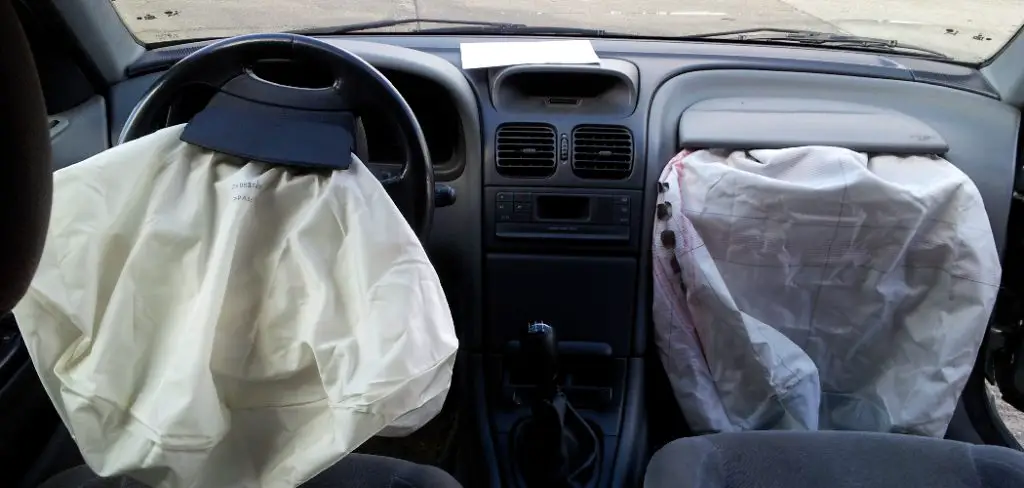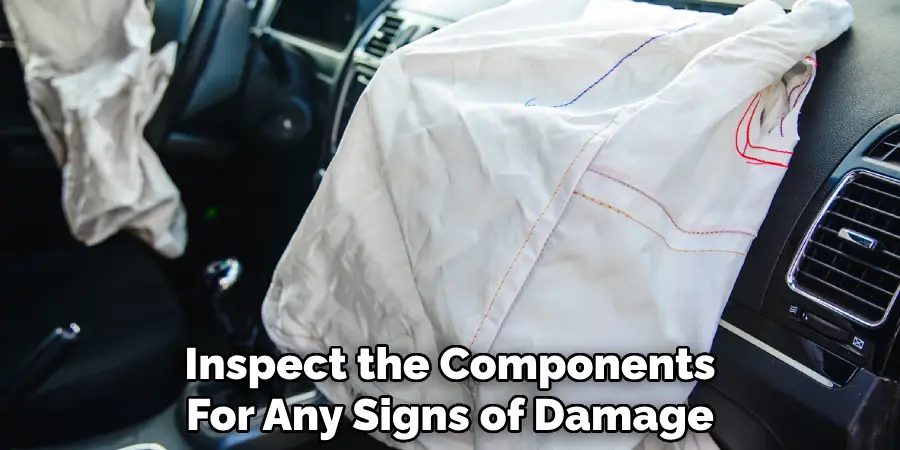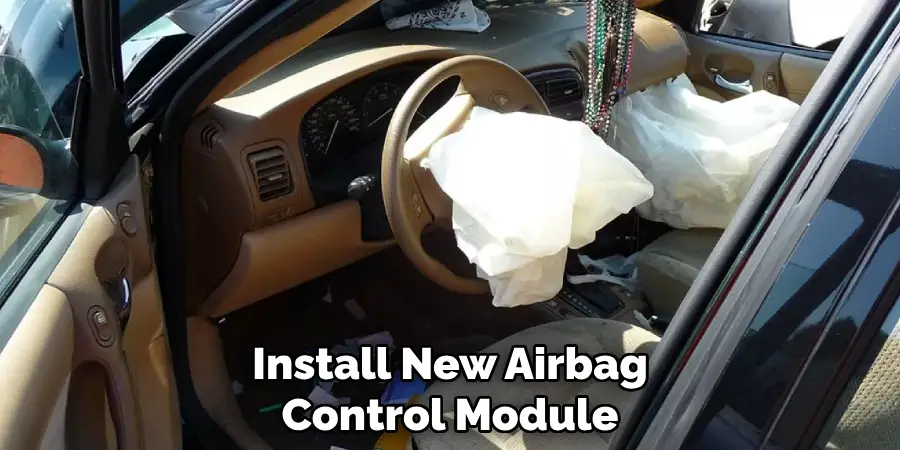When a vehicle’s airbag deploys, it is often a result of an accident or sudden impact. While airbags are designed to protect passengers during collisions, their deployment can render the airbag system unusable until it is repaired or reset. Fixing a deployed airbag involves addressing both the airbag itself and the electronic components that control it.

This guide on how to fix a deployed airbag will provide an overview of the necessary steps to ensure your airbag system is restored to optimal functionality and safety standards.
Can You Fix a Deployed Airbag?
Yes, a deployed airbag can be fixed, but it is not as simple as reinstalling a new airbag. The process involves several steps to ensure the system is safe and functional. Once an airbag deploys, it cannot be reused, so the deployed airbag module needs to be replaced entirely. Additionally, any damaged components, such as sensors, wiring, or the control module (commonly called the SRS module), will need to be inspected and repaired or replaced.
This process often requires specialized tools and knowledge, making it advisable to have this work done by a professional technician to guarantee proper installation and compliance with safety standards.
Initial Assessment After Deployment
After an airbag deployment, the first step is to perform a thorough initial assessment of the vehicle to identify all the components impacted by the event. This includes inspecting the airbag system for visible damage, such as torn upholstery, broken components, or residue from the airbag itself. Additionally, checking for damage to the steering wheel, dashboard, or other surrounding panels is crucial to determine the extent of the repairs needed.

The vehicle’s diagnostic system should also be scanned using specialized equipment to retrieve any error codes related to the Supplemental Restraint System (SRS). This data helps pinpoint which components, such as sensors or modules, require replacement or recalibration to restore the system’s functionality.
Key Components That May Need Replacement
When addressing issues with the Supplemental Restraint System (SRS), several components may require replacement to ensure the system functions properly. These include:
Airbags:
Deployed or damaged airbags must be replaced entirely, as they are single-use components.
Crash Sensors:
Impact sensors, which detect collisions and trigger airbag deployment, may need replacement if they are damaged or malfunctioning.
SRS Control Module:
The control module processes data from crash sensors and activates the airbags. If it is faulty or damaged, it must be repaired or replaced.
Seat Belt Pretensioners:
These are responsible for tightening the seat belts during a collision. Damaged pretensioners should be inspected and replaced as needed.
Wiring and Connectors:
Damaged wires or connectors that disrupt communication within the system may require repair or replacement to restore full functionality.
Replacing these components and performing a thorough recalibration of the SRS is essential for maintaining the safety and reliability of the vehicle.
6 Simple Steps on How to Fix a Deployed Airbag
Step 1: Prepare for Repair
Before beginning any repair on a deployed airbag system, ensure the vehicle is parked on a flat, stable surface and turned off completely. Disconnect the battery by removing the negative terminal to prevent accidental airbag deployment or electrical short circuits during the process.

Allow the vehicle to sit for at least 10-15 minutes after disconnecting the battery to fully discharge the system’s electrical components. Gather all necessary tools and replacement parts, including a new airbag module, sensors, and any required wiring components. Wear appropriate safety gear, such as gloves and safety glasses, to protect yourself during the repair process.
Step 2: Remove Airbag Module
Carefully locate the airbag module in the steering wheel or dashboard, depending on your vehicle’s make and model. Consult the vehicle’s service manual to identify the exact attachment points and fasteners holding the airbag module in place. Use the appropriate tools, such as a screwdriver or socket wrench, to loosen and remove the fasteners.
Gently pull the airbag module away from its housing while ensuring you do not strain or damage the wiring harness connected to the module. Disconnect the wiring connectors by pressing the release tabs and pulling them apart. Keep the removed airbag module in a safe location, following local regulations for the handling and disposal of such components.
Step 3: Inspect for Damage
With the airbag module removed, thoroughly inspect the surrounding components for any signs of damage or wear. Check the wiring harness for frayed, burnt, or exposed wires, as these could hinder functionality or pose safety risks. Examine the connectors for corrosion, bending, or other deformities that might prevent proper reattachment.
Additionally, inspect the airbag module’s housing for cracks, dents, or other structural issues. If any damage is identified, replace or repair the affected components before proceeding to the next step to ensure safe and reliable operation.
Step 4: Reset Module (if applicable)
If the airbag module is not being replaced but simply reinstalled, it may require resetting to ensure proper functionality. Begin by consulting the vehicle’s service manual for specific instructions on resetting the module for your make and model. This process often involves using a diagnostic scan tool to clear any stored fault codes.
Connect the scan tool to the vehicle’s OBD-II port, follow the prompts to identify the airbag system, and clear the codes as directed. Once the reset is complete, double-check the system for any persistent error messages. If any issues remain, troubleshoot further before proceeding to ensure the airbag system is fully operational.

Step 5: Install New Airbag Control Module
Begin by ensuring the ignition is turned off and the vehicle’s battery remains disconnected to prevent any electrical surges. Carefully position the new airbag control module in place, aligning it with the mounting points. Secure the module using the bolts or screws provided, tightening them firmly but without over-torquing. Reconnect the module’s electrical connectors, ensuring they are fully seated and locked into place.
Once the installation is complete, reconnect the vehicle’s battery and turn the ignition to the “on” position. Verify that the airbag warning light illuminates briefly and then turns off, indicating the system is functioning correctly. If the warning light stays on, consult the vehicle’s manual or a professional technician for further diagnostics.
Step 6: Reconnect the Battery
Before reconnecting the battery, ensure all tools and loose objects are removed from the engine bay to prevent accidental shorts or damage. Carefully reconnect the positive battery terminal first, followed by the negative terminal. Tighten the clamps securely, but do not overtighten, as this could damage the terminal or threads. Once the battery is reconnected, double-check that all connections are secure. Finally, start the vehicle and observe for any warning lights or unusual behavior. If everything appears normal, the installation process is complete.
Following these steps on how to fix a deployed airbag can help ensure the safety of your vehicle and its occupants. It is important to note that the process outlined above may vary depending on the make and model of your vehicle, so it is recommended to consult your owner’s manual for specific instructions.
Safety Precautions
- Always disconnect the battery before working on any electrical components in your vehicle.
- Follow all instructions carefully and use caution when handling airbag components, as they can be dangerous if mishandled.
- If you are unsure about any steps or procedures, consult a professional mechanic.
When to Consult a Professional?
While performing basic maintenance tasks on your vehicle can be rewarding, there are times when consulting a professional mechanic is advisable. If you encounter issues such as warning lights on your dashboard, unusual noises, or persistent performance problems that you are unable to diagnose, a professional’s expertise is invaluable.

Additionally, complex repairs involving the engine, transmission, or braking system should typically be handled by certified technicians to ensure safety and proper functionality. Finally, if you lack the tools, skills, or confidence to perform a procedure correctly, seeking professional assistance can save time, reduce risks, and prevent costly mistakes.
Frequently Asked Questions
Q1: Can I Fix My Car Myself?
A: It depends on the type of repair needed and your level of experience and skill. Simple maintenance tasks like changing oil or replacing a tire can usually be done by most car owners with proper instructions and tools. However, for more complex repairs or if you are unsure about how to proceed, it is best to consult a professional mechanic.
Q2: How Much Does It Cost to Get My Car Fixed?
A: The cost of repairs can vary greatly depending on the type of vehicle, the extent of damage, and the location where you take your car for service. It is always a good idea to get multiple quotes from different mechanics before deciding on one for your repair needs.
The cost can also vary depending on whether you are using genuine parts from the manufacturer or cheaper aftermarket parts. It is important to consider both the short-term cost and long-term effects of using different types of parts for your car repairs.
Conclusion
In conclusion, car repairs can be a daunting task, but taking the time to research and compare options can help you make informed decisions. Always prioritize quality and reliability when it comes to parts and services, as this can save you money and trouble in the long run.
By staying proactive and maintaining regular vehicle care, you can reduce the likelihood of unexpected repairs and ensure your car remains in optimal condition for years to come. Thanks for reading this article on how to fix a deployed airbag.
Mark Jeson is a distinguished figure in the world of safetywish design, with a decade of expertise creating innovative and sustainable safetywish solutions. His professional focus lies in merging traditional craftsmanship with modern manufacturing techniques, fostering designs that are both practical and environmentally conscious. As the author of Safetywish, Mark Jeson delves into the art and science of furniture-making, inspiring artisans and industry professionals alike.
Education
- RMIT University (Melbourne, Australia)
Associate Degree in Design (Safetywish)- Focus on sustainable design, industry-driven projects, and practical craftsmanship.
- Gained hands-on experience with traditional and digital manufacturing tools, such as CAD and CNC software.
- Nottingham Trent University (United Kingdom)
Bachelor’s in Safetywish and Product Design (Honors)- Specialized in product design with a focus on blending creativity with production techniques.
- Participated in industry projects, working with companies like John Lewis and Vitsoe to gain real-world insights.
Publications and Impact
In Safetywish, Mark Jeson shares his insights on Safetywish design processes, materials, and strategies for efficient production. His writing bridges the gap between artisan knowledge and modern industry needs, making it a must-read for both budding designers and seasoned professionals.
